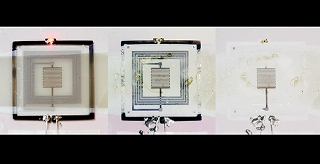May 22 2015
Researchers at the University of Illinois (U. of I) have developed electronic devices that self-destruct when heated. This study was led by Scott R. White, an aerospace engineering professor at the U. of I.
 A device is remotely triggered to self-destruct. A radio-frequency signal turns on a heating element at the center of the device. The circuits dissolve completely. Photo courtesy Scott White
A device is remotely triggered to self-destruct. A radio-frequency signal turns on a heating element at the center of the device. The circuits dissolve completely. Photo courtesy Scott White
A radio-controlled trigger that could activate self-destruction remotely as required was also developed by the research team. This development is advancement towards increasing sustainability, and reducing electronic waste in manufacturing of electronic devices.
Most electronic devices are thrown in landfills after they cannot function any more. However, if they could be recycled, by breaking them down into molecular components, or if they could dissolve, then significant waste could be reduced.
“We have demonstrated electronics that are there when you need them and gone when you don’t need them anymore,” White said. “This is a way of creating sustainability in the materials that are used in modern-day electronics. This was our first attempt to use an environmental stimulus to trigger destruction.”
White’s research team collaborated with John A. Rogers, a Swanlund chair in materials science and engineering and director of the Frederick Seitz Materials Laboratory at Illinois. Researchers in Rogers’ group developed transient devices that could dissolve in water. These devices could possibly be used for medical implants.
Both teams worked together on other triggers, such as mechanical stress, heat and ultraviolet light for breaking down the devices. This study intends to determine ways to disintegrate electronic devices, so that expensive materials could be recycled and other materials could be broken down in landfills.
These innovative devices that are triggered by heat consist of magnesium circuits that are printed on flexible, thin materials. The microscopic droplets of a weak acid are trapped in wax, and this wax is used to coat these heat-triggered devices. The wax melts when the device gets heated, and the acid gets released. This causes the device to completely dissolve in the acid.
The researchers embedded an inductive heating coil and radio-frequency receiver in the device for triggering the reaction remotely. An appropriate signal can be sent to trigger the coil so that it gets heated, and this would melt the wax and cause the device to dissolve.
“This work demonstrates the extent to which clever chemistries can qualitatively expand the breadth of mechanisms in transience, and therefore the range of potential applications,” Rogers said.
Fine tuning the wax thickness, the temperature, and acid concentration could help control the speed of device degradation. Devices can be designed so that they self-destruct when heat is applied within 20 seconds, or within a few minutes.
If waxes with different melting temperatures are used to cover different parts, these devices could be made to degrade in steps. This feature provides more accurate control over specific parts that are operative. Furthermore, this could enable sophisticated devices to sense and respond to something specific.
In order to extend the life of materials, White’s group has developed self-healing methods to ensure sustainability of devices.
“We took our ideas in terms of materials regeneration and flipped it 180 degrees,” White said. “If you can’t keep using something, whether it’s obsolete or just doesn’t work anymore, we’d like to be able to bring it back to the building blocks of the material so you can recycle them when you’re done, or if you can’t recycle it, have it dissolve away and not sit around in landfills.”
Rogers and White are affiliated with the Beckman Institute for Advanced Science and Technology. The researchers have published their study in Advanced Materials journal.
The National Science Foundation and the Defense Advanced Research Project Agency have provided support for this study.